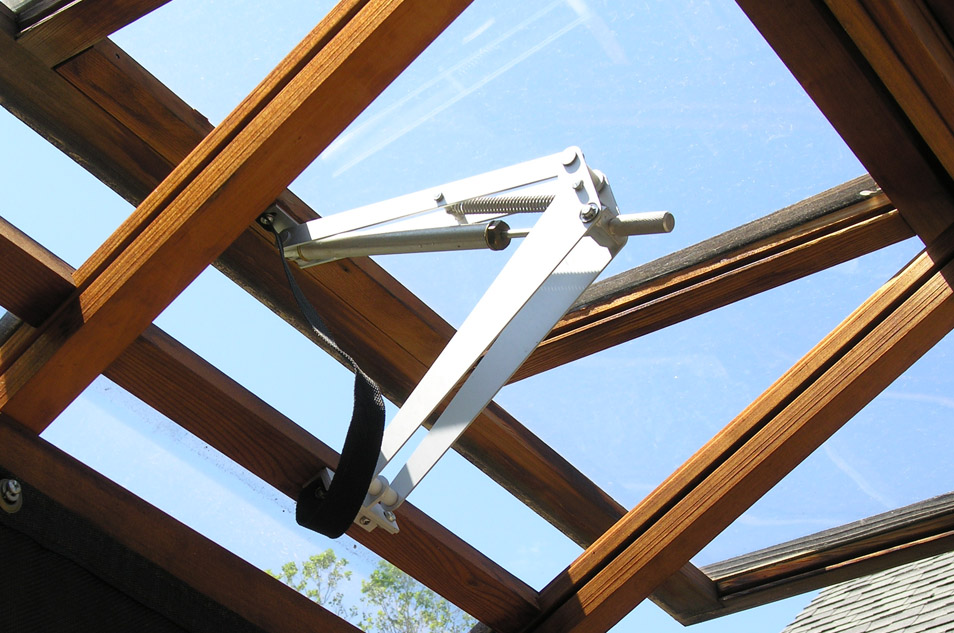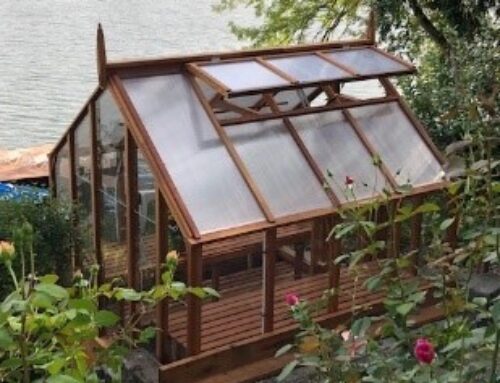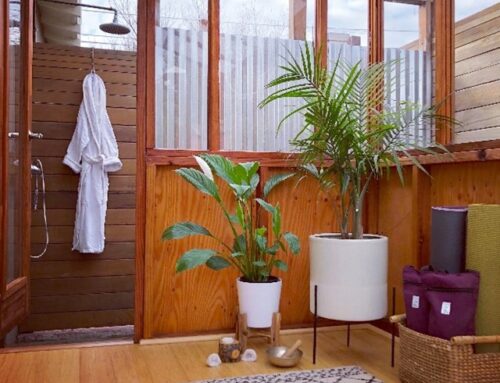Maintaining optimal temperature and airflow in your greenhouse is crucial for the health and productivity of your plants. As the air temperature rises, finding effective cooling and ventilation solutions becomes paramount. In this blog post, we will explore the best ways to cool and ventilate your greenhouse, all of which are options that can be incorporated into a Sturdi-Built Greenhouse, allowing you to create a comfortable and thriving environment for your beloved plants.
Natural Ventilation: Harnessing the power of natural ventilation is an excellent starting point for cooling your greenhouse. Automated roof vent openers for wide roof vents at the greenhouse ridge, which come standard in all Sturdi-Built greenhouse models, allow hot air to rise and escape, promoting effective air exchange and preventing heat buildup, provided that the temperature outside the greenhouse is cooler. This helps regulate the temperature inside the greenhouse, creating a more comfortable and favorable environment for plant growth. Roof vents also help control humidity levels by allowing excess moisture to escape, reducing the risk of fungal diseases. One simple way to increase ventilation is to open your greenhouse windows during cooler periods to permit fresh air to circulate. Adding louvered windows, often referred to as “jalousie windows” can be manually opened and adjusted to allow warmer air to escape is another easy way to get additional ventilation. These can be installed in the gable end walls as well as the side walls of a greenhouse. Strategic placement of jalousie windows on opposite sides of the greenhouse creates a natural cross breeze, facilitating effective air exchange. Remember to consider prevailing wind direction to maximize airflow.
Shade Cloth and Glazing: Direct sunlight can significantly increase temperatures inside the greenhouse. By installing shade cloth, you can mitigate heat buildup by regulating the amount of sunlight and heat that enters the greenhouse which will reduce the risk of plant stress and plant sunburn. Opt for shade cloth with a high percentage of shade factor, such as 55%, 63%, or 73% to strike the right balance between shade and light penetration. Additionally, consider the type of glazing material for your greenhouse. Sturdi-Built offers twin wall polycarbonate with built-in UV protection for the roof, which can help filter sunlight by 10% while maintaining excellent light transmission.
Evaporative Air Coolers and Misting Systems: Evaporative cooling is an efficient and eco-friendly method to reduce temperatures in your greenhouse. By utilizing evaporative air coolers or misting systems, you can create a cool and refreshing environment for your plants. Evaporative air coolers have pads within them that are soaked with water, and as the air passes through them, it cools down before circulating throughout the space. Misting systems work by emitting a fine mist of water droplets into the air, which evaporates and cools the surrounding environment. As the water evaporates, it absorbs heat from the air, resulting in a temperature reduction. Misting systems can be strategically placed throughout the greenhouse to create a widespread cooling effect. They are particularly beneficial in dry climates or during hot summer months when temperatures can soar. Misting systems not only lower the temperature but also increase humidity, creating a more comfortable and favorable environment for plants to thrive. Both evaporative air coolers and misting systems work by harnessing the cooling effect of water evaporation.
Thermal Mass: Using thermal mass is an effective technique for keeping greenhouse temperatures consistent. Thermal mass refers to materials that can absorb, store, and release heat slowly over time. Thermal mass elements such as water barrels or a concrete base wall absorb excess heat during the day and release it during cooler periods, helping to stabilize temperature fluctuations. Building your base wall out of concrete, placing thermal mass elements strategically throughout the greenhouse, or by attaching your greenhouse to a wall with a high thermal value helps to create a thermal buffer, regulating temperature and preventing extreme highs and lows. Using thermal mass can reduce the need for additional heating or cooling systems and provide a more stable and comfortable environment for plant growth.
Circulation Fans: Circulation fans offer several benefits for greenhouses. Firstly, they help improve air circulation, ensuring that fresh air reaches all parts of the greenhouse. This promotes more even distribution of temperature, humidity, and CO2 levels, which are essential for healthy plant growth. Circulation fans also help prevent the formation of stagnant air, reducing the risk of mold, fungal diseases, and pests. Additionally, they aid in strengthening plant stems by gently stimulating airflow around them. With their ability to enhance ventilation and create a more uniform growing environment, circulation fans contribute to improved plant health and overall greenhouse productivity.
Thermometers: Using a thermometer allows growers to monitor and maintain optimal temperature conditions for their plants. By accurately measuring the temperature, growers can adjust heating, cooling, or ventilation systems to ensure plants thrive in the ideal temperature range. A thermometer also helps identify temperature fluctuations or extremes that can stress or damage plants. Additionally, tracking temperature allows growers to make informed decisions about planting schedules or adjusting growing techniques. Overall, a thermometer is an essential tool for creating a favorable and controlled environment, promoting healthy plant growth, and maximizing greenhouse productivity. Sturdi-Built offers both wireless and blue tooth thermometers with a hygrometer for easy use.
Exhaust Fans: Exhaust fans help to remove stale and hot air from the greenhouse, allowing for better air exchange and preventing heat buildup. By expelling hot air, the exhaust fan helps to regulate the temperature inside the greenhouse, creating a more comfortable environment for plants. Additionally, the constant airflow created by the exhaust fan helps to prevent the formation of condensation, reducing the risk of fungal diseases. Moreover, the removal of excess humidity and gases improves air quality, promoting healthier plant growth. Overall, installing an exhaust fan is a wise investment to maintain optimal conditions and maximize the productivity of your greenhouse. If you are an orchid grower or live in a high-altitude area, an exhaust fan may not be the best solution as it can create a dryer environment than what is optimal for your plants.
Insulation: Insulation plays a crucial role in regulating greenhouse temperatures. By insulating the walls, roof, and even the floor, it helps to minimize heat transfer, preventing excessive heat loss during cold periods and reducing heat gain during hot periods. Insulation acts as a barrier, trapping air and creating a buffer zone that helps to maintain a more stable and favorable temperature inside the greenhouse. This not only protects plants from extreme temperature fluctuations but also reduces the energy required for heating or cooling. Proper insulation ensures a more efficient use of heating systems, allowing growers to create a consistent and controlled environment for optimal plant growth. Our unique Thermal Option is a great way to not only provide more stable temperatures in the winter, but also in the hottest parts of the year. When adding insulation is to avoid any insulation that traps moisture – so to avoid mold growth.
Walipini/Pit Greenhouses: Walipini greenhouses, also known as underground or pit greenhouses, excel at regulating temperature in a natural and efficient way. The design of a walipini greenhouse involves partially burying it into the ground, taking advantage of the Earth’s natural insulation. The thermal mass of the surrounding soil helps to stabilize temperature extremes, keeping the greenhouse cooler in the summer and warmer in the winter. The underground structure acts as a barrier against external temperature fluctuations and provides a more constant environment for plants. Additionally, the design often incorporates ventilation systems to ensure proper airflow, further aiding in temperature regulation. Overall, walipini greenhouses offer a sustainable and effective method of maintaining optimal temperature conditions for year-round gardening.
Conclusion: Maintaining an ideal growing environment in your greenhouse requires effective cooling and ventilation strategies. By implementing natural ventilation, shade cloth, evaporative cooling, fans, automated controls, cooling systems, and insulation, you can successfully manage temperature, airflow, and humidity levels. Remember to assess your specific needs, adapt to changing weather conditions, and monitor plant requirements. With the right combination of techniques and tools, your greenhouse will provide a comfortable and thriving space for your plants to flourish, ensuring a successful and rewarding gardening experience.










Leave A Comment